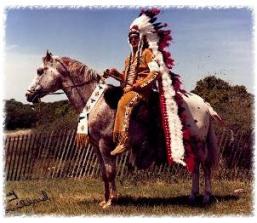|

The spotted horse, known today as the Appaloosa, existed long before recorded history, and is perhaps one of the oldest recognizable breeds. Horses with spotted coats were depicted on cave walls in France dating about 18,000 B.C. and on statues and pottery in ancient China. He was known as the Sacred Horse of Nisasea, the Heavenly Horse and Le Tigre depending on which region of the Old World he was found. Prized and selectively bred, by the 1600s he had been developed into a stylish breed with sleek conformation and brilliant coat markings.
It is believed the spotted horse was imported to Mexico, wandered its way north and by the early 1700s, was acquired by the Nez Perce Indians of the Northwest. The Nez Perces selective breeding practices enabled them to develop their horses into superb animals with intelligence, courage, speed and stamina. Their spotted horse became known as a Palouse horse so called because so many of them were seen along the Palouse River. It wasn't long before they were called by the modern name, Appaloosa.
By the 1870s, advancement of the white man into the secluded northwest, changed life for the Nez Perce people. Forced to leave their homelands for a reservation, Chief Joseph, his people and their horses attempted to flee to Canada. For almost four months and covering 1100 miles of extreme terrain, the Nez Perce continued to elude General Howard and the cavalry. In October of 1877, with his people weak from cold and hunger, Chief Joseph surrendered, but not before White Bird and some of the Nez Perce escaped to Canada with several Appaloosa horses.
Stories had reached many people of how the spotted horses aided the Nez Perce in their flight and this created a demand for the Appaloosa. Many were sold off to white men who bred them indiscriminately only to produce the fancy coat patterns. Conformation and quality didn't matter and the fine Appaloosa breed was nearly destroyed.
Efforts to revive the Appaloosa horse to its former greatness were undertaken in both the United States and Canada. Individual horses with the desired characteristics were sought out and breeding programs established that would enable the Appaloosa horse to make a comeback. The Appaloosa Horse Club of Canada was formed in 1954 through the efforts of James Wyatt, an Alberta rancher and Dr. Grant MacEwan. Today the ApHCC is a strong organization that provides programs for all Appaloosa enthusiasts and maintains the official registry for Appaloosa horses in Canada as recognized under the Animal Pedigree Act.
|





